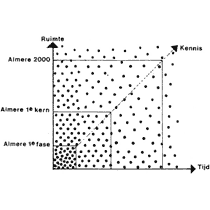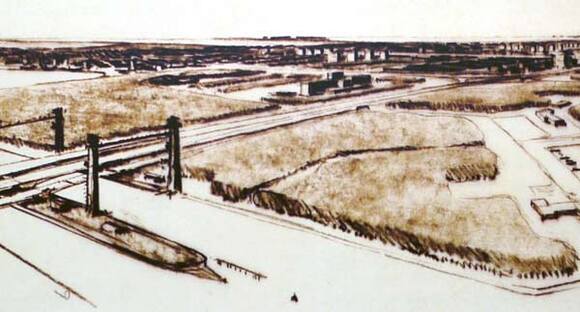
The crisis of ‘make-ability’ and the image of the future in physical planning and design
Planning and designing inherently means to anticipate the future in a most comprehensive way; that is, to have an image of the future that includes both proposed, projected interventions and expected circumstances for those interventions. Planners, designers and decision-makers make their decisions based on partly explicit and partly implicit assumptions regarding the future course of events. The further the planning horizon recedes, and the larger the scale of intervention becomes, the greater complexity and hence uncertainty on the exact workings of events determining the course. Accordingly, the explicit assumptions of the future change in form. Kees van der Heijden, a futurologist, has suggested a tripartition of the realm of the future: forecasts as adequate images for the short-term future and scenarios for mid-term projects. For the long-term future, the only adequate image is simply hope. [1] In other words, physical planners, designers, and decision-makers concerned with such tasks have to be optimistic.
The planners of the Dutch governmental planning agency for the IJsselmeer polders (RIJP) regarded this optimism as a prerequisite for any planning: “Without the expectation that the future is (for a part) makeable and controllable, for which one has no other means than today’s knowledge, any planning is meaningless. If the aim of planning is the pursuit of a better quality of life for future generations, then one has to be optimistic about the possibilities to reach that goal.” [2] The word ’makeable’ is a rough translation of the Dutch word ’maakbaar’, a concept that extended the skills of engineering one’s own territory through large-scale water works to the belief in the malleability of society itself. Well into the 1960s at least, most planners and designers in the Netherlands were trained in this spirit of ‘make-ability’. The ‘make-ability’ of society (’de maakbaarheid van de samenleving’) meant engineering in the broadest sense: both physically and socially. During the First World War, this concept had become part of the Netherlands’ national mythology, as expressed in the inscription of the memorial for engineer Cornelis Lely, inaugurated upon completion of the Barrier Dam: ’A nation that lives builds its own future.’ [3]
But what future was it that the Dutch nation had to build? Traditionally, public administrators saw themselves as benevolent technocrats using scientific methods to evaluate rational ways towards the good of the greatest number. Their pride lay not least in their dispassionate views on politics – government could, and had to, indicate long-term goals and directions, but the experts would prepare their choice, and fill in the equations in its wake. However, the inevitability of experts taking sides had already been noted by American planning professor Melvin Webber and philosopher of science Horst Rittel: “Whichever the tactic, though, it should be clear that the expert is also the player in a political game, seeking to promote his private vision of goodness over others’. Planning is a component of politics. There is no escaping that truism.” [4] Imposing an official vision of goodness was (mostly uncontested) common procedure during the Dutch reconstruction era. Planners had therefore no need to question their methods, their values, or their physical designs beyond their own evaluation methods. The societal changes that started in the 1960s put a halt to this smooth operation of the planning machinery. In the wake of a rising pluralist society and increasing complexity, planners became aware of their role in the political game. Four large-scale projects exemplify the resulting changes in form and function of the image of the future in planning: modern architect Cornelis van Eesteren’s comprehensive visionary Leitbild for Lelystad (ca. 1960-65), Almere Planning Office’s reduced and abstract models of infrastructure sketches for Almere (ca. 1970-1975), RIJP’s colorful alternative extreme program scenarios for the Markerwaard (ca. 1975-1980), and The Netherlands Now As Design’s comprehensive futurologist scenarios based on competing political values for New Netherlands 2050 (ca. 1980-1985). Amidst increasing opposition to governmental planning, these projects reveal a transition from planning as engineering to planning as politics. Planners not only had to provide solutions for specific problems, but also organize political and public support – both for the urgency of the problem and the proposed solution. As a component of politics, comprehensive planning divided into two distinct yet connected ventures: pragmatic day-to-day design, and political vision. [5]
Towards pragmatic design: from Cornelis van Eesteren’s Lelystad Leitbild to models for Almere
In the 1960s, Willem Steigenga, first professor for physical planning in the Netherlands, firmly advocated the ideal of the civil servant as neutral expert-engineer. [6] Working out alternative plans had to be a central working method, but only if planners remained indifferent on the desirability of their options and let politicians choose. However, Willem Steigenga’s concept went much further than creating options. Realizing the intricate interdependencies of values, societal structure, and physical environment, he proposed to elaborate sets of comprehensive ’social-spatial constructions’ for ideal societies instead. This was advanced technocracy for complex issues, based on utopian thinking and a firm belief in ‘make-ability’. Willem Steigenga was a planning theorist who emphasized the importance of the process, but he deemed a detailed visualization of possible future states indispensable for making today’s decisions. For those visions, architects seemed to be the right experts, since they had not lost their naïveté, and hence the ability for utopian thinking.
In praxis, things went differently. Cornelis van Eesteren’s early plans for Lelystad were such a vision. [7] The architect claimed that they were merely a Leitbild (general model), and not a binding blueprint for a future modernist city of a hundred thousand inhabitants. But RIJP’s planning commission regarded the proposals as too inflexible and too little concerned with the process of urbanization, which they considered to be the central task of the commission. Eventually, the architect lost his commission, and the planning commission members themselves began to draw rather abstract structure schemes instead. In the end, these schemes became Lelystad. A commission member later remarked that the main problem had not been the discussion between process and product, but that all participants had not made clear what they meant by talking about a city: what was missing was a comprehensive image of the future: a clear vision of the city-to-be (fig. 1). [8]

For Almere, the planners wanted to avoid the problem that RIJP had encountered in the early planning phase of Lelystad. Their suggestion was to implement Willem Steigenga’s approach of first answering the fundamental questions about society and form before making any decisions on building. [9] In the real-life grand project of planning a new city, the planners were increasingly marginalized by the urban designers. The concept of first conceiving a comprehensive future image of an ideal society, and then discovering the ways towards this ideal, proved to be naïve. It would not only take too much time and effort in a fast-paced planning and decision process, it also turned out to be impossible due to the complexity of the task, notably as the planners strictly adhered to their so-called scientific methods, such as the newly developed planning tools of cross-impact analyses, balanced score sheets, and the like. Not least of all, it became obvious that experts could not be as neutral as demanded, both politically and regarding principal values. The tight planning schedule demanded quick decisions, notably for starting infrastructure works with long lead times and sand-filling for preparing building grounds. The planners eventually conceded that their task was made impossible by inherent uncontrollable complexities of the project and the fundamental lack of knowledge about the precise relationship between society and space (fig. 2).
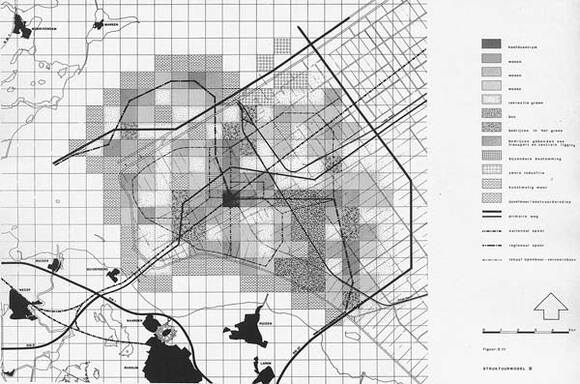
Almere’s planners were not the only ones faced with these problems. The early 1970s were a time of general uncertainty for Western societies. Following the sharp drop in birth rates and the Oil Price Crisis, previously un-thought-of uncertainties surfaced; notably in forecasting population numbers, economic development, energy consumption, environmental pollution, and supply with all kinds of resources. In a diagram that was apparently an adaptation of a diagram in the introductory chapter of the contemporary book The Limits to Growth, Almere’s planners showed their understanding of the general relationship between knowledge and physical planning. The diagram was a declaration of visionary bankruptcy: it was, in principle, not possible to elaborate a comprehensive image of any long-term, large-scale future. Instead, decisions had to be taken step-by-step without a leading vision. Obviously, this could not answer the question of what future urban society was aspired, nor what the concept city meant to its makers. Accordingly, the planners gave up on their earlier aspirations and instead declared: “It is not possible but also not necessary to define precisely and forever what is understood as a city, urbanity, or urbanization.” [10] For the planners, no optimal solution was therefore possible. A “satisfactory realization of objectives for all relevant actors in the urbanization process” would have to do (fig. 3.1, 3.2). [11]
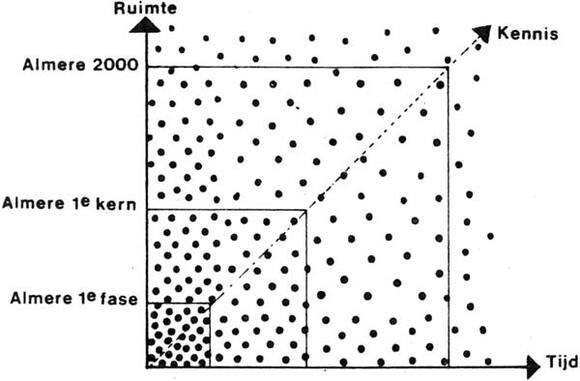
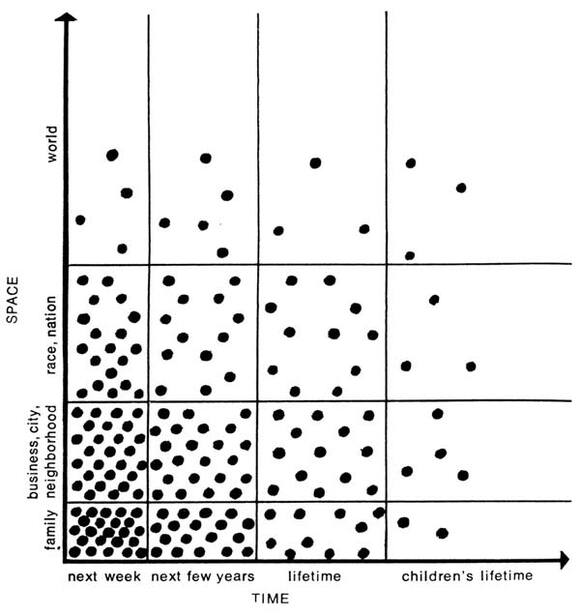
All the while the planners met up with the limits of their methods, the designers, led by urban designer Teun Koolhaas and landscape architect Alle Hosper, simply drew those images of the far future. However, they did not draw any comprehensive plans, nor did they state what the future city would be like. Instead, they limited their drawings to the most elemental parts of the city: the main infrastructure, the distribution of built and unbuilt areas and density numbers for the population. These sketches were called models, and their function lay in making decisions based on the comparison of alternative physical forms. That was traditional architectural design logic: a stepwise narrowing down of options, working in a descending order of scales and issues, and an iterative evolution of form, all based on a graphic working method in maps, diagrams, and plan sketches. That the future of the city was unforeseeable seemed justified, since any process of urbanization was unforeseeable as well. [12] The aim was to make Almere an open city for an open society through the provision of as much flexibility as possible. However, there would be a downside that had to be accepted: “The working method has the consequence that one abstains from the characteristics and qualities of an extreme solution. Flexibility is per definition of neutral character (fig. 4).” [13]
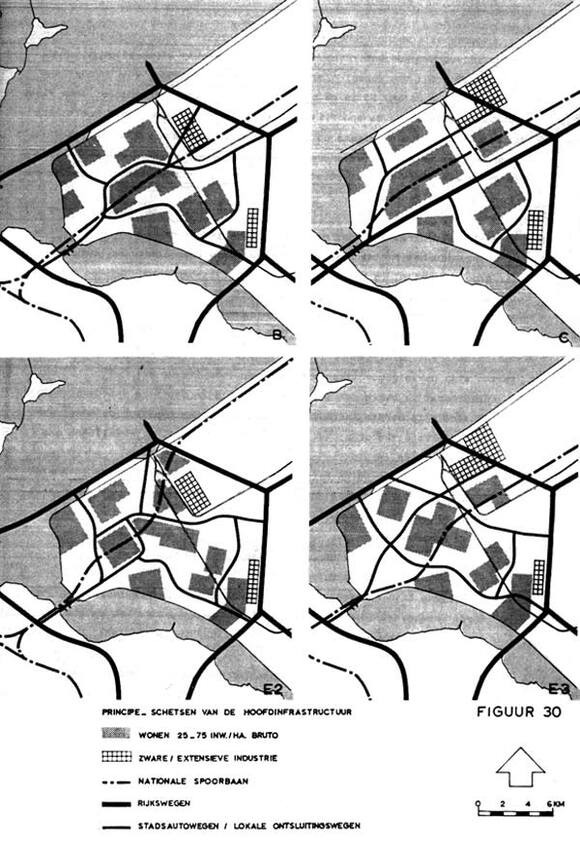
This neutrality, as it seems today, may be both one of greatest assets of Almere’s urban structure as well as one of its major problems. The city’s early planning documents reveal this increasing antagonism between the planners, trained as social geographers and economists, and the designers, who were architects, landscape architects, and urban designers. Almere was designed very pragmatically, meaning that the designers accepted their incomplete knowledge, rejected a utopian future image, and eventually settled on providing a structure as open as possible for a multitude of possible future social and physical structures.
From extreme programs to extreme politics: scenarios for the Markerwaard and New Netherlands 2050
It was only possible to design a city without any vision or political commitment because Almere was planned for an almost blank slate; the pristine reclaimed lands of the Southern Flevo polder. Without concerned inhabitants or local politicians, there was not much public interest in the plans. But maybe this was less a result of the commission than of timing. When RIJP began to start planning and designing for the last missing Zuiderzee polder, the Markerwaard, the agency was surprised to meet strong resistance to their plans. The opposition came from outside official politics and administration, and it lead not only eventually to the fact that the Markerwaard still remains unbuilt, but also to a fundamental change in planning methods for large-scale projects.
The main opposition to land reclamation came from a group of professionals and laymen who had founded the Association for the Protection of the IJsselmeer (VBIJ). [14] Their motives were mixed. Some wanted to keep the large water body of the Marker lake open for fishing, others for recreational sailing, or as a natural habitat. Some feared that the new polder would provide space for hazardous programs such as the second national airport and military training grounds, others saw the historic waterfronts of the old fishing villages endangered. The movement was mainly driven by environmental concerns, general mistrust of large-scale economic and technological projects, and rising critique of governmental paternalism and the societal concept of ‘necessary progress’. The protest was fueled by uncertainty about the projects on the side of the government itself. For starting the planning process, The Hague had demanded a report from RIJP that listed all possible variants for the new polder. [15] RIJP included the option of not building the Markerwaard at all, but only the dikes and water works necessary for water management and flood protection. VBIJ took the hint and added another, more radical plan without building anything at all: the Waterlely plan. [16] It was a planning report mixed with evocative photographs and descriptions of threatening future developments, such as the prophecy that after the reclamation of the Markerwaard, the Wadden sea would be next.
RIJP’s planners and designers, led by urban designers Dirk Frieling and Teun Koolhaas, heard the signals, and tried to counter these claims. The main argument was programmatic: as the new Markerwaard was very easy to make, Dutch society should not miss out on that opportunity. What the new polder would be used for was another question. There would therefore be two different issues: one was whether to build a new polder, and the other was what to do with it. The first had already been answered by parliament and governments, and commissioned to RIJP. The second was open, and RIJP attempted to show that possible future uses came with many options. The Markerwaard was therefore drawn in four alternative scenarios, each corresponding to an extreme program: agriculture, leisure, nature, and urbanization. [17] Urbanization was a euphemism for unwanted industrialization, and more agriculture was demanded by farmers’ lobbies. However, leisure and nature were core demands of the opposition. In four somewhat less radical scenarios that combined programs along different main topics, RIJP wanted to give attractive images of the future to ease opposition. At the same time, the design exercise was made to decide on a one-size-fits-all outer contour line for the ring dike. With such a contour, the two decisions could indeed be taken separately (fig. 5).
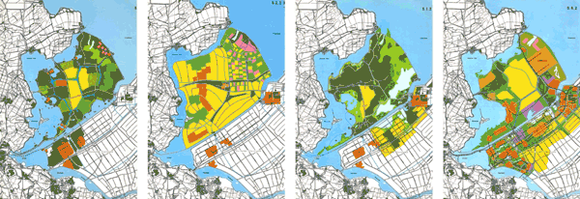
RIJP’s use of parallel alternative images of the future in the form of design scenarios was new. However, the report failed to impress the opposition, who considered the first question of much greater importance than the eventual program in the polder, which they regarded as out of their control. In an increasingly turbulent economic and political environment, the reclamation of the Markerwaard was eventually abandoned. RIJP’s planners had not succeeded in securing enough political and societal support for their problem, and their proposed solutions could not convince the critics. After decades of large-scale planning, Dutch land reclamation came to an unexpected premature end, and the agency was disbanded.
For the planners, it was extremely frustrating to face the futility of years of working. Dirk Frieling, RIJP’s deputy director for the Markerwaard, put these feelings into words when he gave a lecture to an international audience of design students shortly before RIJP’s decommissioning: “As you will know, Utopia is sometimes translated as Nowhere land. And indeed in the present situation, the designated area for Utopia being a lake, there is nowhere land. Since I am a member of the design coalition team that has been commissioned to design this Utopia, you may see me as a real nowhere man, sitting in my nowhere land making all my nowhere plans for nobody.” [18] To Dirk Frieling and other planners of RIJP, it had become obvious that Dutch society’s implicit consensus on a way into the future based on governmental planning and technological progress had become contested. Considering the scale and the prominent place of waterworks in the Netherlands, it was less of a surprise that the Markerwaard became the battlefield for the turning of the tide. But for planners, turning away from planning for the future was certainly not an option. It was a sign of societal, if not cultural weariness, as urban designer S. J. van Embden remarked: “Now the high-spirited verve of the 70s ebbs away [...] there is little left of the pre-war optimism and belief in the future, which had actually kept, almost uninterruptedly, on the go the entire western world since the Enlightenment. For now, [the cultural sector] is dominated by skepticism, nostalgia [heimwee] for a past that is dreamt of as safe, and above all, a nearly apocalyptical doom thinking, for which most of all the world of natural and technical sciences is blamed. [...] And on top of that [...] the general opposition [weerzin] and the fears, evoked by the inevitable side effects of the persevering industrialization and mechanization.” [19] The planners’ diagnosis of the failure of the Markerwaard project was not due to any problem on the side of planning. The problem was a societal fatigue, embodied by the Report to the Club of Rome. The cure would therefore not be an improvement to planning (for example through societal participation), rather, planning would have to cure society, since, as Dirk Frieling claimed, “it may in theory be true that there are limits to growth but in practice it is nonsense. For the time being, that is for the centuries to come, we should aim at growth. [...] I should like to suggest that as a follow-up to "the limits to growth" we should take the initiative for a second look at the predicament of mankind which might result in a report called: "the opportunities for growth". For if we ever want to realize Utopia in this world, we can better start to design it, rather than tell each other what it is not.” [20] He did not only call for action, but had already started such an initiative. It was the five-year non-governmental planning and design event ’The Netherlands Now As Design’ (NNAO). [21] It was a unique collaboration of geographers, planners, designers and other experts to produce four distinct images of the future: the scenarios of ’New Netherlands 2050’. The aim of the exercise was twofold: to convince society that the future had to be made, and to promote the planning and design disciplines for making that future. In the early 1980s, large-scale and long-range planning and design commissions had become rare in the wake of economic decline and in the rise of liberal concepts in politics (fig. 6).
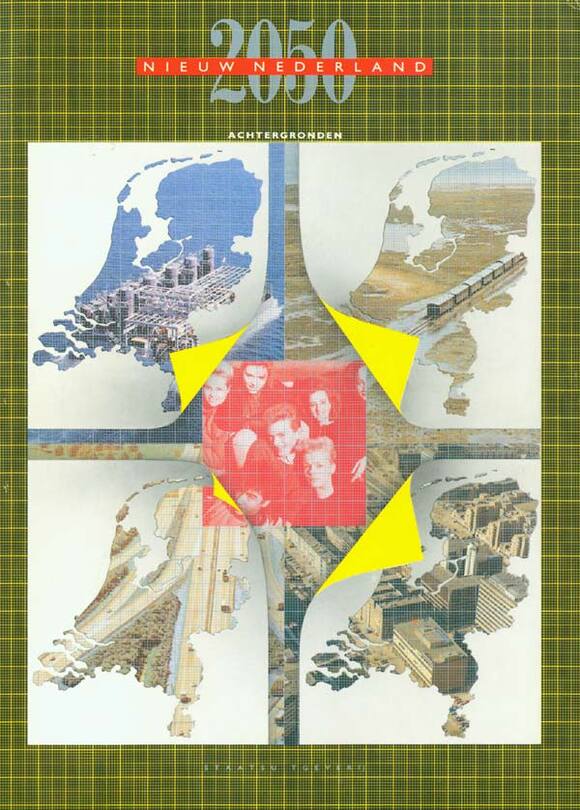
NNAO embraced the spirit of ‘make-ability’, yet its working method was the scenario method. Whereas the Markerwaard scenarios had been based on alternative programs, the futures of the Netherlands had to be comprehensive images that included both future society and future physical form. Thinking more than seventy years ahead was a venture in the field of futurology, and that is where the long genealogy of the NNAO scenarios had started twenty years earlier. [22] The general setup followed Dirk Frieling’s idea that the fundamental question which vision a society had to follow had to be answered not by planners, but by politics. This was basically in line with Willem Steigenga, but he argued that the decisions would not have to be simply administered by government. Instead, this had to be done through the proven mechanisms of party politics, at least in the Netherlands and comparable Western societies based on the political concepts of the French revolution. The Dutch Scientific Council for Government Policy (WRR) supported the venture and commissioned the elaboration of three images of the future based on the assumption of continuous extreme political decisions for each. The result was three alternatives: a future Christian-conservative, a future liberal, and a future socialist Netherlands. NNAO added a fourth, which was a technocratic or planners’ scenario. These four scenarios were first elaborated as written narratives and rough programs, then handed over to teams of designers and planners who visualized them on national, regional, and local scales (fig. 7).
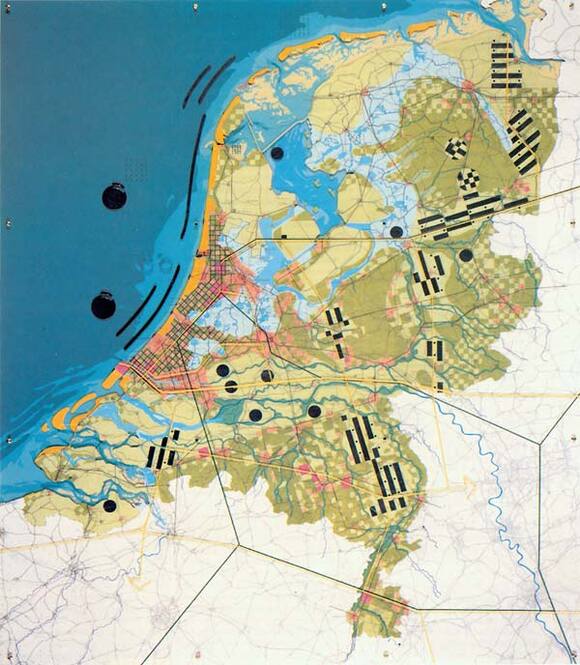
In NNAO, planners’ and designers’ neutral expert roles were reestablished, but with a twist: they had to become politically active to prove that they could make the future. What they would make was not their decision. The attractive, comprehensive, and vividly visualized image of the future was not a Leitbild to follow. It merely had to be attractive enough for citizens and politicians to allow planners to make the future at all. The aim of these visions was not any building site, but rather public opinion. In other words, the scenarios of the future Netherlands were no longer comprehensive engineering plans, but an exercise in planners’ and designers’ new field of engineering consent. However, NNAO’s makers did not fully trust politics to take the right decision, and hence added the fourth scenario as their preferred option. This so-called ’relaxed’ scenario was a classic utopia.
Despite great efforts and large budgets, NNAO was much less successful than its makers expected in drawing large audiences and many visitors. But to many of the participating designers and planners, it became an influential experience for their professional development. Not only did they make first contact with the innovative working method of scenarios, but also with members of other disciplines. Regarding the curious career of the scenario method in Dutch physical planning and design in the 1990s, the greatest legacy of the event seems to have been the rediscovery of utopian thinking in physical planning and design.
[1] Kees van der Heijden, Scenarios: The Art of Strategic Conversation, 2nd ed., John Wiley, Chichester, 2005.
[2] Rijksdienst voor de IJsselmeerpolders, “Denkbeeld Voor Een Struktuur Van Het Ijsselmeergebied. Uitgebracht Aan De Commissie Markerwaard Van De Raad Van Advies Voor De Ruimtelijke Ordening in Aansluiting Op Het Rapport “Markerwaard, 10 Jaar Droog”,” ed. Rijkswaterstaat, Direktie Zuiderzeewerken; Ministerie van Verkeer en Waterstaat (Lelystad1981). p.9f
[3] Auke van der Woud, ‘De Geschiedenis Van De Toekomst’, in: Nieuw Nederland: Onderwerp Van Ontwerp – Nieuw Nederland 2050, Boek I, Achtergronden, ed. Stichting Nederland Nu Als Ontwerp and Hans van der Cammen, Staatsuigeverij, ‘s Gravenhage, 1987.
[4] Horst W. J. Rittel and Melvin M. Webber, Dilemmas in a General Theory of Planning’, Policy Sciences 4, no. 2, 1973, p.169.
[5] Christian Salewski, ‘Dutch New Worlds : Scenarios in Physical Planning and Design in the Netherlands, 1970-2000’, Diss., Eidgenössische Technische Hochschule ETH Zürich, Nr. 19286, 2010.
[6] Willem Steigenga, ‘Van Sociale Analyse Naar Sociaal-Ruimtelijke Konstruktie. Rede Gehouden Bij Aanvaarding Van Het Ambt Van Gewoon Hoogleraar in De Planologie En De Demografie Aan De Universiteit Van Amsterdam Op 19 November 1962’, Universiteit van Amsterdam, 1962.
[7] Zef Hemel, Cornelis Van Eesteren, Architect Urbanist / Iv. Het Landschap Van De IJsselmeerpolders, NAi, Rotterdam, 1999.
[8] Commenting on the Structure Sketch from 1969. Coen Van der Wal, In Praise of Common Sense Planning the Ordinary a Physical Planning History of the New Towns in the IJsselmeerpolders, 010, Rotterdam, 1997, p.183.
[9] Ibid.
[10] Rijksdienst voor de IJsselmeerpolders and Projectburo Almere, Verkenningen 2. Stedelijk Gebied Almere (Concept), Lelystad, 1972, p.1.2f.
[11] Ibid. p.1.6.
[12] Ibid. p.1.2.
[13] Rijkswaterstaat, Direktie Zuiderzeewerken; Ministerie van Verkeer en Waterstaat (ed), Almere in Regionaal Kader: Ruimtelijke Struktuuralternatieven. Discussienota, Lelystad 1975, p.35.
[14] Jaap van der Zwaag et al., Markerwaard/Markermeer: Witboek Ijsselmeer, Kosmos + Vereninging tot Behoud van het IJsselmeer, Amsterdam 1980.
[15] Rijkswaterstaat and Dienst der Zuiderzeewerken, Beschouwingen over De Markerwaard. Nota Nr. 276, Rijkswaterstaat, ‘s Gravenhage 1972.
[16] Vereniging tot behoud van het IJsselmeer, Plan Waterlely, Edam 1974.
[17] Rijksdienst voor de IJsselmeerpolders, R.J. Brandsema, and M. Spierings, ‘Verkenningen Markerwaard’, Dienst der Zuiderzeewerken, Flevobericht, Lelystad 1975.
[18] Dirk Frieling, ‘A visit to Nowhereland’, in: Max Bruinsma (ed.), Markerwaard: The Other Side of Design: Water and Land, Myth or Mind, De Balie, Amsterdam, 1988, p.27f. Italics in the original.
[19] S.J. van Embden, ‘Over Vormgevers En Vormgeving in De Nederlandse Stedebouw Van De 20e Eeuw’, in: F. de Jong (ed.), Stedebouw in Nederland: 50 Jaar Bond Van Nederlandse Stedebouwkundigen, Walburg, Zutphen, 1985, p.76.
[20] Frieling op. cit. p.35.
[21] Stichting Nederland Nu Als Ontwerp and Hans van der Cammen, (eds.), Nieuw Nederland: Onderwerp Van Ontwerp – Nieuw Nederland 2050, Boek I, Achtergronden, Staatsuitgeverij, ‘s Gravenhage, 1987.
[22] The process was initiated by Herman Kahn’s introduction of the scenario method for large-scale images of the future of society, which prompted a critical answer by The Club of Rome that became seminal: ‘The Limits to Growth’. Herman Kahn and Anthony Wiener, The Year 2000. A Framework for Speculation on the Next Thirty-Three Years (New York, London: MacMillan, 1967). - Club of Rome and Donella H. Meadows, The Limits to Growth a Report for the Club of Rome’s Project on the Predicament of Mankind (New York1972). - OECD, Interfutures Research Project On “The Future Development of Advanced Industrial Societies in Harmony with That of Developing Countries” Final Report (Paris: OECD, 1979). - Wetenschappelijke Raad voor het Regeringsbeleid, “Beleidsgerichte Toekomstverkenning. Deel 2: Een Verruiming Van Perspectief,” in Rapporten aan de Regering, ed. WRR (‘s-Gravenhage1983). - Rob van Engelsdorp Gastelaars et al., Ruimtelijke Verkenningen: Drie Schetsen Voor De Toekomstige Inrichting Van Nederland, Delftse Universitaire Pers, 1987.




